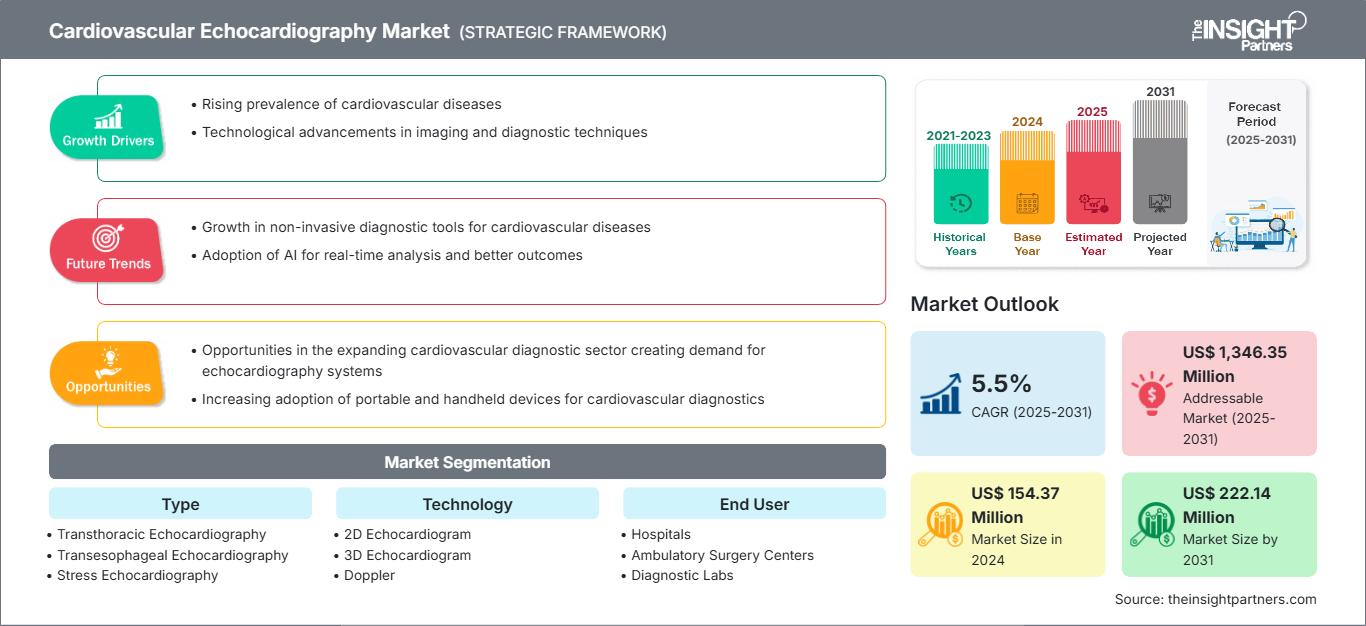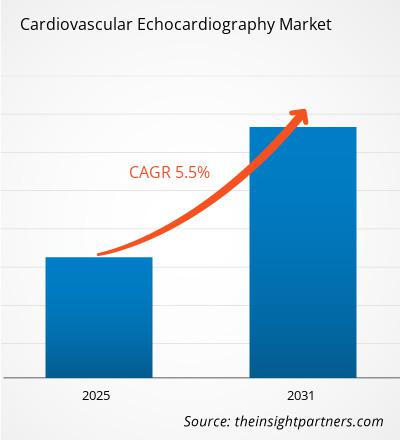[Forschungsbericht] Der Markt für kardiovaskuläre Echokardiographie soll von 154,37 Millionen US-Dollar im Jahr 2024 auf 222,14 Millionen US-Dollar im Jahr 2031 anwachsen; für den Zeitraum 2025–2031 wird ein durchschnittliches jährliches Wachstum von 5,5 % erwartet.
Markteinblicke und Analystenmeinung:
Die kardiovaskuläre Echokardiographie ist eine medizinische Bildgebungsmethode zur Untersuchung des Herzens. Dabei werden Schallwellen verwendet, um visuelle Bilder des Herzens zu erzeugen. Dieses Testverfahren wird üblicherweise bei Patienten mit vermuteten oder bekannten Herzerkrankungen durchgeführt. Neben der Darstellung von Größe und Form der Herzkammern und Herzklappen schätzt der Test auch die Herzfunktion ein, indem das Herzzeitvolumen, die Auswurffraktion und die diastolische Funktion berechnet werden. Das kardiovaskuläre Echokardiogramm kann auch Kardiomyopathien erkennen. Die Verletzungen eines früheren Herzinfarkts können mithilfe von Echokardiogrammen deutlich dargestellt werden. Zu den verschiedenen Herzultraschalluntersuchungen, die zu diagnostischen Zwecken durchgeführt werden, gehören der transthorakale, der transösophageale und der Belastungs-Ultraschall. Die steigende Zahl an Herz-Kreislauf-Erkrankungen und die wachsende geriatrische Bevölkerung werden voraussichtlich reichlich Chancen für das Wachstum des Marktes für kardiovaskuläre Echokardiographie schaffen.
Wachstumstreiber:
Bei der Untersuchung und Beurteilung von Herzinfarkt, Brustschmerzen, koronarer Herzkrankheit, Blutgerinnseln und anderen Herzerkrankungen empfehlen Ärzte invasive Behandlungen, die Blutuntersuchungen und eine Herzkatheterisierung beinhalten. Eine Herzkatheterisierung erfordert einen längeren Krankenhausaufenthalt und verursacht bestimmte Nebenwirkungen wie Blutungen, Blutgerinnsel, Arterienschäden und andere Komplikationen. Aus diesen Gründen schränken Ärzte die Anwendung dieses Verfahrens zur Herzdiagnose in der Regel ein und greifen stattdessen auf nukleare Belastungstests, Magnetresonanztomographie, Herzultraschall und eine koronare Computertomographie (CT) zurück, da diese Verfahren nichtinvasiv durchgeführt werden.
Die Echokardiographie ist nach der Elektrokardiographie und der Röntgenaufnahme des Brustkorbs die am häufigsten verwendete kardiovaskuläre Diagnoseuntersuchung. Es handelt sich um ein nichtinvasives Diagnoseverfahren, das Informationen zur Herzfunktion und Hämodynamik liefert. Da Echokardiogramme im Vergleich zu anderen strahlenbasierten Diagnoseverfahren nur minimale oder gar keine Risiken bergen, sind diese Geräte in Krankenhäusern und Diagnosezentren weit verbreitet. Patienten mit Herzinsuffizienz in der Vorgeschichte profitieren von der Routineüberwachung mit diesen Herzdiagnosegeräten. Sie helfen auch, den Krankheitsverlauf und die Wirksamkeit von Behandlungen oder Operationen zu überwachen. Echokardiogramme werden auch in der regulären Pflege von Krebspatienten eingesetzt, bei denen ein Risiko für Kardiotoxizität besteht.
Die Vorteile von Echokardiographiegeräten gegenüber anderen kardiologischen Diagnoseverfahren fördern ihre Verbreitung und damit das Wachstum des Marktes für kardiovaskuläre Echokardiographie.
Zu den Markttrends im Bereich der kardiovaskulären Echokardiographie gehört die Integration von KI und anderen innovativen Technologien in Echokardiographiegeräte.
Passen Sie diesen Bericht Ihren Anforderungen an
Sie erhalten kostenlos Anpassungen an jedem Bericht, einschließlich Teilen dieses Berichts oder einer Analyse auf Länderebene, eines Excel-Datenpakets sowie tolle Angebote und Rabatte für Start-ups und Universitäten.
Markt für kardiovaskuläre Echokardiographie: Strategische Einblicke

-
Holen Sie sich die wichtigsten Markttrends aus diesem Bericht.Dieses KOSTENLOSE Beispiel umfasst Datenanalysen, die von Markttrends bis hin zu Schätzungen und Prognosen reichen.
Segmentierung und Umfang des Berichts:
Die Marktanalyse für kardiovaskuläre Echokardiographie wurde unter Berücksichtigung der folgenden Segmente durchgeführt: Typ, Technologie, Endbenutzer und Geografie. Basierend auf dem Typ ist der Markt in transthorakale Echokardiographie, transösophageale Echokardiographie, Stressechokardiographie und fetale Echokardiographie segmentiert. In Bezug auf die Technologie ist der Markt in 2D-Echokardiogramm, 3D-Echokardiogramm und Doppler unterteilt. Basierend auf dem Endbenutzer ist der Markt in Krankenhäuser, ambulante Operationszentren und Diagnoselabore kategorisiert. Der Umfang des Marktberichts für kardiovaskuläre Echokardiographie umfasst Nordamerika (USA, Kanada und Mexiko), Europa (Frankreich, Deutschland, Großbritannien, Spanien, Italien und das übrige Europa), den Asien-Pazifik-Raum (China, Japan, Indien, Australien, Südkorea und den übrigen Asien-Pazifik-Raum), den Nahen Osten und Afrika (Saudi-Arabien, Südafrika, die Vereinigten Arabischen Emirate und den übrigen Nahen Osten und Afrika) sowie Süd- und Südamerika. Mittelamerika (Brasilien, Argentinien und der Rest von Süd- und Mittelamerika).
Segmentanalyse:
Der Markt für kardiovaskuläre Echokardiographie wird nach Typ in transthorakale Echokardiographie, Stressechokardiographie, transösophageale Echokardiographie und fetale Echokardiographie unterteilt. Das Segment der transthorakalen Echokardiographie hatte 2022 einen bedeutenden Marktanteil. Es wird erwartet, dass es zwischen 2022 und 2030 die höchste CAGR auf dem Markt verzeichnet.
Basierend auf der Technologie wird der Markt in 2D-Echokardiogramm, 3D-Echokardiogramm und Doppler unterteilt. Das Segment des 3D-Echokardiogramms hatte 2022 einen bedeutenden Marktanteil auf dem Gebiet der kardiovaskulären Echokardiographie und wird voraussichtlich zwischen 2022 und 2030 die höchste CAGR verzeichnen.
Basierend auf dem Endbenutzer wird der Markt in Krankenhäuser, ambulante Operationszentren und Diagnoselabore segmentiert. Das Krankenhaussegment hatte im Jahr 2022 einen bedeutenden Marktanteil im Bereich der kardiovaskulären Echokardiographie und wird voraussichtlich zwischen 2022 und 2030 die höchste durchschnittliche jährliche Wachstumsrate verzeichnen.
Kardiovaskuläre Echokardiographie
Regionale Einblicke in den Markt für kardiovaskuläre EchokardiographieDie Analysten von The Insight Partners haben die regionalen Trends und Faktoren, die den Markt für kardiovaskuläre Echokardiographie im Prognosezeitraum beeinflussen, ausführlich erläutert. In diesem Abschnitt werden auch die Marktsegmente und die geografische Lage in Nordamerika, Europa, dem asiatisch-pazifischen Raum, dem Nahen Osten und Afrika sowie Süd- und Mittelamerika erörtert.
Umfang des Marktberichts zur kardiovaskulären Echokardiographie
| Berichtsattribut | Einzelheiten |
|---|---|
| Marktgröße in 2024 | US$ 154.37 Million |
| Marktgröße nach 2031 | US$ 222.14 Million |
| Globale CAGR (2025 - 2031) | 5.5% |
| Historische Daten | 2021-2023 |
| Prognosezeitraum | 2025-2031 |
| Abgedeckte Segmente |
By Typ
|
| Abgedeckte Regionen und Länder |
Nordamerika
|
| Marktführer und wichtige Unternehmensprofile |
|
Dichte der Marktteilnehmer im Bereich der kardiovaskulären Echokardiographie: Verständnis ihrer Auswirkungen auf die Geschäftsdynamik
Der Markt für kardiovaskuläre Echokardiographie wächst rasant. Dies ist auf die steigende Nachfrage der Endverbraucher zurückzuführen, die auf Faktoren wie veränderte Verbraucherpräferenzen, technologische Fortschritte und ein stärkeres Bewusstsein für die Produktvorteile zurückzuführen ist. Mit der steigenden Nachfrage erweitern Unternehmen ihr Angebot, entwickeln Innovationen, um den Bedürfnissen der Verbraucher gerecht zu werden, und nutzen neue Trends, was das Marktwachstum weiter ankurbelt.

- Holen Sie sich die Markt für kardiovaskuläre Echokardiographie Übersicht der wichtigsten Akteure
Regionale Analyse:
Geographisch ist der Markt für kardiovaskuläre Echokardiographie in Nordamerika, Europa, Asien-Pazifik, Süd- und Mittelamerika sowie den Nahen Osten und Afrika unterteilt. Im Jahr 2022 eroberte Nordamerika einen bedeutenden Marktanteil. Im Jahr 2022 dominierten die USA den Markt in dieser Region. Das Marktwachstum in Nordamerika ist auf die steigende Zahl von Herzerkrankungen, die zunehmende geriatrische Bevölkerung und die Präsenz wichtiger Marktteilnehmer in der Region zurückzuführen.
Herzerkrankungen sind eine der häufigsten Todesursachen in den USA. Laut den Centers for Disease Control and Prevention (CDC) erleiden in den USA jedes Jahr rund 805.000 Menschen einen Herzinfarkt. Darüber hinaus ist die koronare Herzkrankheit die häufigste Art von Herzkrankheit; im Jahr 2019 starben daran 360.900 Menschen. Laut CDC wird geschätzt, dass im Jahr 2030 in den USA 12,1 Millionen Menschen an Vorhofflimmern leiden werden. Und laut dem Canadian Chronic Disease Surveillance System lebt etwa jeder Zwölfte (2,6 Millionen) kanadische Erwachsene ab 20 Jahren mit einer diagnostizierten Herzkrankheit im Land. Laut Statistics Canada starben im Jahr 2020 67.399 Menschen an Herzkrankheiten oder Schlaganfällen. Die steigende Zahl der Herz-Kreislauf-Erkrankungen betrifft also einen beträchtlichen Teil der Bevölkerung. Dies führt zu einer größeren Nachfrage nach Diagnoseinstrumenten wie der kardiovaskulären Echokardiographie, um die kardiovaskuläre Gesundheit zu beurteilen und zu überwachen, und treibt so den Markt für kardiovaskuläre Echokardiographie in der Region voran.
Wettbewerbslandschaft und wichtige Unternehmen:
Die Marktprognose für kardiovaskuläre Echokardiographie kann Beteiligten bei der Planung ihrer Wachstumsstrategien helfen. Zu den führenden Akteuren im Marktbericht zur kardiovaskulären Echokardiographie zählen Apex Heart and Vascular, Ultra-X Imaging, Metropolitan Heart Vascular Institute, Ultromics Limited, Corewell Health, Centinela Hospital Medical Center, Schoolcraft Memorial Hospital, University of Utah Health, Goshen Heart & Vascular Center und Harefield Hospital. Diese Unternehmen konzentrieren sich auf die Einführung neuer Hightech-Produkte, die Weiterentwicklung bestehender Produkte und die geografische Expansion, um der weltweit wachsenden Verbrauchernachfrage gerecht zu werden.
- Historische Analyse (2 Jahre), Basisjahr, Prognose (7 Jahre) mit CAGR
- PEST- und SWOT-Analyse
- Marktgröße Wert/Volumen – Global, Regional, Land
- Branchen- und Wettbewerbslandschaft
- Excel-Datensatz
Aktuelle Berichte
Erfahrungsberichte
Grund zum Kauf
- Fundierte Entscheidungsfindung
- Marktdynamik verstehen
- Wettbewerbsanalyse
- Kundeneinblicke
- Marktprognosen
- Risikominimierung
- Strategische Planung
- Investitionsbegründung
- Identifizierung neuer Märkte
- Verbesserung von Marketingstrategien
- Steigerung der Betriebseffizienz
- Anpassung an regulatorische Trends






















 Kostenlose Probe anfordern für - Markt für kardiovaskuläre Echokardiographie
Kostenlose Probe anfordern für - Markt für kardiovaskuläre Echokardiographie